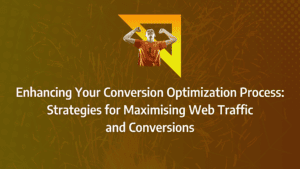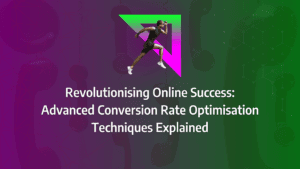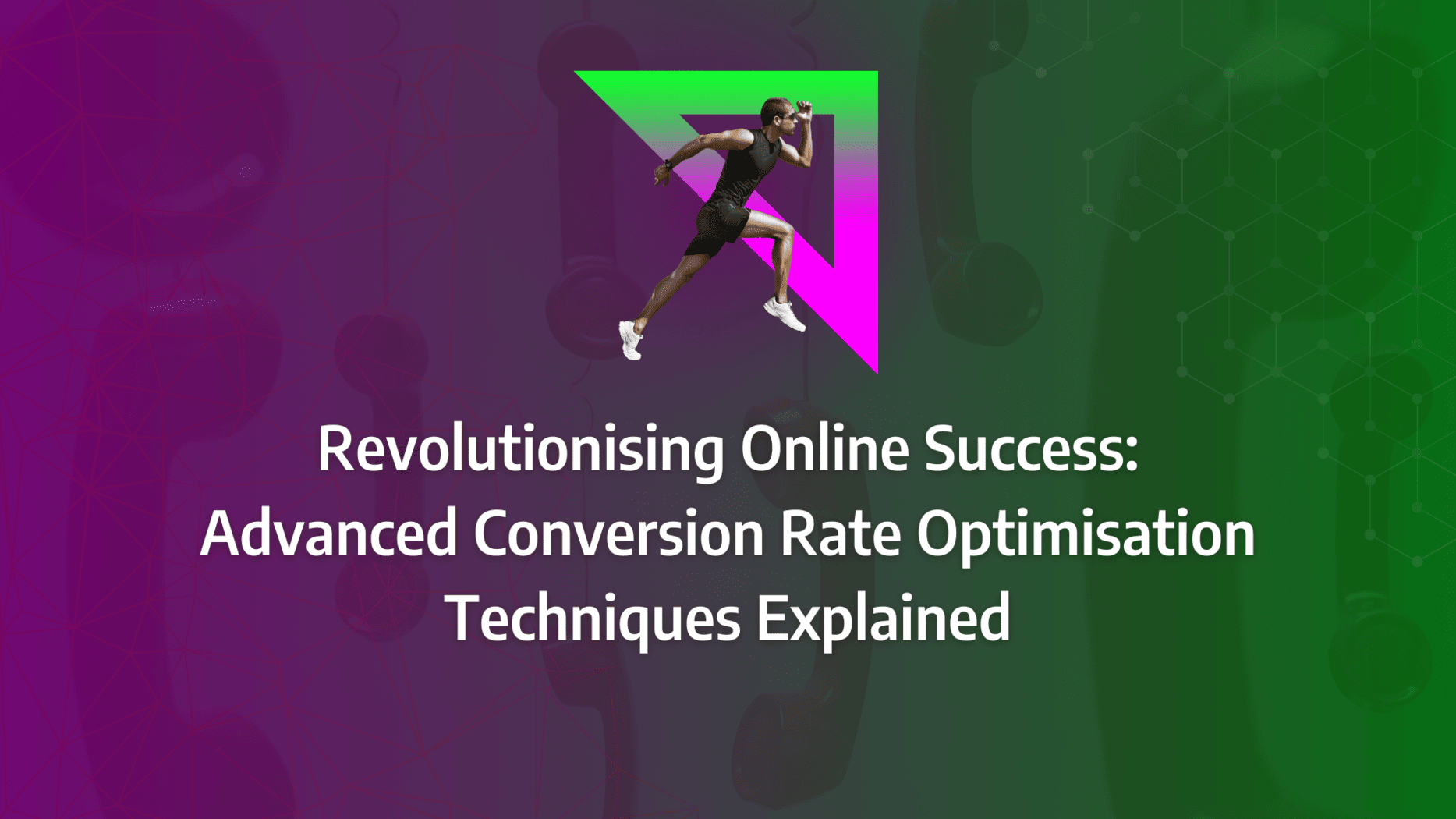Imagine transforming every click on your website into a tangible opportunity for growth. Conversion Rate Optimisation (CRO) is not just a buzzword—it’s a strategic powerhouse that can skyrocket your business’s success. Whether you’re struggling with high bounce rates or seeking to maximise your marketing ROI, understanding and implementing CRO strategies can make all the difference.
In this blog, we delve into the core benefits of CRO, providing you with actionable insights and proven tactics that will enhance your user experience, increase your revenue, and offer deeper insights into customer behaviour.
- Understand the Power of CRO: Conversion Rate Optimisation is crucial for transforming website visitors into active customers, ultimately boosting your business growth.
- Improve User Experience: Implementing CRO strategies enhances user experience by optimising website elements like landing pages, which encourages visitors to engage more deeply with your content.
- Increase Revenue: By fine-tuning your website’s conversion points, you can significantly increase revenue without necessarily driving more traffic.
- Leverage Data and Analytics: Use tools like A/B testing and heat maps to gather actionable insights and make informed decisions that improve conversion rates.
- Learn from Success Stories: Examine case studies of successful CRO implementations to understand the tangible benefits and apply similar strategies to your own business.
- Stay Ahead with Emerging Trends: Keep up with the latest trends in CRO, such as AI-driven personalisation and mobile optimisation, to maintain a competitive edge.
Why is Understanding Conversion Rates Crucial?
Conversion rate optimisation (CRO) is the strategic process of increasing the percentage of visitors to your website or digital platform who complete a desired action, such as making a purchase or signing up for a newsletter. This desired action is referred to as a “conversion event.”
To optimise your conversion rate, you must delve into the behavioural patterns of your audience, analysing what drives them to complete these conversion events and what hinders them. With this data in hand, you can implement changes designed to remove barriers and enhance the likelihood of conversion, thereby improving your overall business performance.
Why Is Conversion Rate Important?
Conversion rates serve as critical benchmarks for any business, offering insight into how effectively your digital platforms are engaging users and driving desired outcomes. Before exploring the benefits of conversion rate optimisation in detail, it’s important to grasp why tracking your conversion rate is fundamental to your business strategy.
Consider the analogy of running a buffet restaurant. You offer a variety of dishes in warming pans for your guests to self-serve. To operate efficiently, you need to track how many guests choose each dish. For example, if you regularly prepare tilapia fillets but few guests choose to eat them, you’re wasting resources on a dish that isn’t popular, which could lead to financial losses.
In this scenario, each time a guest selects a tilapia fillet, it counts as a conversion. The act of accepting your offering is akin to a customer engaging with your website’s call-to-action. Understanding the ratio of guests who choose tilapia helps you adjust the quantity prepared, minimising waste and maximising profit.
Similarly, on your website, you need to monitor how many visitors accept your offer—whether that’s making a purchase, filling out a form, or any other conversion event—relative to the total number of visitors. This insight allows you to fine-tune your strategy to better meet customer needs and improve overall conversion rates.
What Matters Most?
From our experience, understanding customer psychology is vital for developing effective conversion optimisation strategies. Clients often discover that aligning these strategies with broader business goals ensures their optimisation efforts contribute meaningfully to overall brand success. Additionally, recognising the entire customer journey enables organisations to pinpoint friction points that can hinder conversions, paving the way for more targeted improvements.Get In Touch
How can I measure the success of my conversion rate optimisation efforts?
Calculating your conversion rate is just the starting point. To fully harness the power of conversion rate optimisation, you need to consider a broader spectrum of metrics that provide a more comprehensive understanding of your website’s performance and potential profitability.
Customer Lifetime Value
Customer Lifetime Value (CLV) is a vital metric that measures the total revenue you can expect from a single customer throughout their relationship with your business. For example, if a customer makes a single purchase of £99 and never returns, their lifetime value is £99. However, if that same customer makes a £99 purchase every year for ten years, their CLV rises to £990.
Your goal should be to convert high-value customers who are likely to remain engaged with your brand over the long term. This requires not just attracting customers but retaining them and maximising their value over time.
Value Per Visitor
Another crucial metric is the value per visitor. This is calculated by dividing the total revenue generated over a specific period by the number of visitors to your site. For instance, if 1,000 people visit your website in a week and 30 of them purchase £99 products, your total revenue for that period would be £2,970. Dividing this by the total number of visitors (1,000) gives you a value per visitor of £2.97.
Understanding these metrics is essential for developing a robust conversion rate optimisation strategy, as they help you identify where your website is excelling and where there’s room for improvement.
What Are the Benefits of Conversion Rate Optimisation?
Understanding the myriad benefits of conversion rate optimisation (CRO) is essential for any business looking to maximise its digital presence. By strategically enhancing your website’s performance, you can not only increase conversion rates but also significantly improve user engagement and brand credibility.
Boost Visitor Engagement: One of the key benefits of conversion rate optimisation is its ability to enhance visitor engagement on your website. By meticulously optimising various elements—such as side banners, meta tags, internal linking structures, and page load times—you can create a more compelling and interactive user experience. These enhancements not only keep visitors on your site longer but also encourage deeper interaction with your content, which is crucial for driving conversions.
Improved Conversion Rates: Effective conversion optimisation strategies can substantially increase your lead generation and conversion rates. Employing advanced conversion rate optimisation techniques, such as A/B testing, incorporating lead flows within your blog posts, and adding well-crafted FAQs, can help you capture and convert more leads at scale. These methods are proven to streamline the user journey, making it easier for visitors to take the desired actions, thereby improving your overall conversion rates.
Source: WebFX
Personalised Content: Another significant advantage of conversion rate optimisation is the ability to deliver highly personalised content to your audience. Tailoring elements such as FAQs, blog posts, and call-to-action (CTA) buttons to individual user preferences can dramatically reduce bounce rates and enhance user engagement. By leveraging data-driven insights, you can create a more personalised user experience that resonates with your audience and drives sustained engagement and lead generation.
Enhanced Brand Credibility: Conversion rate optimisation also plays a pivotal role in building and enhancing your brand’s credibility. By implementing optimised web forms and capturing essential user information, such as email addresses and phone numbers, you can foster trust and establish stronger relationships with your audience. This approach not only increases the likelihood of conversion but also strengthens your brand’s reputation as a reliable and credible entity in the market.
Scale Your Marketing Efforts: Finally, a well-executed conversion rate optimisation strategy enables you to scale your marketing efforts more effectively. By improving the efficiency of your conversion processes, you can connect with a broader audience and amplify the impact of your marketing campaigns. This scalability ensures that as your business grows, your marketing efforts can expand in tandem, driving higher conversion rates and optimising overall campaign performance.
What specific tactics can boost visitor engagement on my website?
To fully harness the power of conversion rate optimisation (CRO), it’s essential to implement best practices that not only boost your web traffic but also enhance user engagement and click-through rates. Below are nine highly effective conversion rate optimisation techniques designed to help you achieve these goals.
1. Run Effective CRO Tests
The foundation of any successful conversion rate optimisation strategy lies in rigorous testing. Begin by formulating a clear hypothesis about your website’s current performance and what you aim to achieve through optimisation. This hypothesis should pinpoint specific issues within your site and articulate why implementing conversion rate optimisation techniques will address these challenges.
Hypothesis Example: Identify areas where user experience may be lacking, such as slow load times or unclear navigation paths, and hypothesise that improving these elements will lead to higher conversion rates.
Goals Example: Clearly define your optimisation goals, whether it’s increasing lead generation, boosting page clicks, or enhancing your Google rankings. Setting these goals will guide your CRO efforts and provide measurable outcomes to assess success.
2. Create a CRO Tech Stack
Once your hypothesis and goals are in place, the next step is to build a robust CRO tech stack. Selecting the right tools is crucial for executing your conversion optimisation strategy effectively. Below are nine essential tools that can significantly enhance your conversion rates:
- Google Analytics: A vital tool for tracking your website’s performance over time, identifying which pages drive traffic and conversions, and pinpointing areas that need improvement.
- Google Optimize: This tool allows you to A/B test different elements of your website to determine what works best. Its features include A/B testing, redirect testing, personalisation, and multivariate testing, making it indispensable for fine-tuning your site.
- Hotjar: As a heat-mapping tool, Hotjar provides insights into user behaviour on your site, showing you which elements attract the most attention and how users navigate your pages.
3. Implement Lead Generation Forms
Lead generation forms are a cornerstone of any conversion rate optimisation strategy. By incorporating innovative and strategically placed lead gen forms, you can significantly boost your lead capture efforts. Consider these five creative lead gen forms:
- Pop-Ups: These are highly effective for grabbing user attention at critical moments, such as when they land on a page or scroll through content.
- Sign-Up Boxes: Well-designed sign-up boxes can enhance your click-through rates by making it easy for users to provide essential data, such as their email addresses.
- Landing Pages: Engage users with dedicated landing pages that are tailored to specific campaigns or offers, designed to convert at scale.
- Wheel of Fortune: This interactive form element invites users to spin a wheel for discounts or special offers, making the user experience more engaging and fun.
- Registration Forms: Simplify the process of collecting detailed user information, such as names and email addresses, through well-optimised registration forms that can also enhance brand credibility.
4. Keep Lead Gen Forms Concise
When designing lead gen forms, conciseness is key. Overloading forms with too many fields—such as first name, email address, company, job title, and phone number—can overwhelm users and lead to increased bounce rates. Instead, streamline your forms to focus on collecting only the most critical information, making it easier for users to complete the process and for your sales team to follow up.
5. Leveraging Social Proof to Enhance Conversion Optimisation
Incorporating social proof into your conversion optimisation strategy is a powerful way to build brand trust and drive conversions. By showcasing the experiences and endorsements of others, you provide potential customers with the confidence they need to engage with your brand. Here are six types of social proof that you can seamlessly integrate into your conversion rate optimisation techniques:
- Social Media Sharing: Highlighting how often your content is shared across social media platforms can enhance credibility and demonstrate your brand’s popularity.
- Review Scores: Displaying aggregated review scores from trusted platforms can quickly convey the quality and reliability of your products or services.
- Customer Reviews: Featuring customer reviews, particularly those that provide detailed feedback, helps prospective clients see real-world applications of your offerings.
- Certifications: Showcasing industry-recognised certifications adds a layer of authority and trustworthiness to your brand.
- Earned Media: Highlighting mentions of your brand in reputable media outlets serves as an external validation of your credibility.
- Testimonials: Personal testimonials from satisfied customers can be a persuasive tool in converting hesitant visitors into loyal clients.
6. Continuous Implementation of CRO Best Practices
Conversion rate optimisation is not a one-time task but an ongoing process that requires consistent effort to maximise results. Here are five steps to ensure that your CRO practices are continually refined and effective:
- Research: Start by analysing key data points such as user feedback, heat maps, web traffic, and click patterns. This research forms the foundation of your optimisation strategy.
- Ideate: Based on your analysis, brainstorm new conversion rate optimisation techniques that can address identified issues and enhance user experience.
- Prioritise: Focus on the most impactful changes first, whether that’s updating content, improving site speed, or refining user navigation paths.
- A/B Testing: Implement A/B testing to compare the performance of your changes against the original setup. This will help you determine which alterations yield the best conversion rates.
- Review: After implementing changes, revisit your data to assess the effectiveness of your strategy. Continuous review ensures that your optimisation efforts are aligned with your overall business goals.
7. Crafting Engaging Call-to-Actions (CTAs)
Call-to-action (CTA) buttons are critical in guiding users through the sales funnel and prompting them to take the desired actions. To create CTAs that truly resonate with your audience and drive conversions, consider the following tips:
- Distinctive Colour: Ensure that your CTA buttons stand out by using a colour that contrasts with the background, drawing immediate attention to the desired action.
- Compelling Copy: The text on your CTA should be clear, concise, and resonate with your audience’s needs or desires. Strong verbs and persuasive language are key.
- Clear Outline: Use visual elements such as shapes or borders to make your CTA buttons visually distinct, making it easy for users to identify where to click.
8. Analysing Your CRO Results for Continuous Improvement
Once you have implemented your conversion rate optimisation strategy, it’s crucial to analyse the outcomes to understand what worked and what didn’t. This reflective process involves asking key questions:
- Why did my conversions increase? Identify the specific changes that led to improved conversion rates to replicate success in other areas.
- Why didn’t I convert more leads? Understanding where and why potential leads dropped off can help you refine your strategy further.
- Did I achieve my CRO goals? Assess whether your optimisation efforts met the goals you set. If not, delve into the reasons and adjust your approach accordingly.
- What insights have I gained about my target audience? Use your findings to deepen your understanding of your audience’s behaviours and preferences, which can inform future optimisation strategies.
- How can I apply these learnings to other webpages? Leverage successful tactics across your website to ensure a consistently high level of user experience and conversion optimisation.
Our Tactical Recommendations
Implementing A/B testing as a regular practice is essential for fostering a culture of continuous experimentation and improvement in conversion rates. Clients often find that prioritising user experience (UX) leads to significant increases in conversions, often from minor adjustments. Moreover, focusing on emotional triggers in your messaging can dramatically enhance customer connections, ultimately resulting in higher conversion outcomes.Get In Touch
What are the common mistakes to avoid in conversion rate optimisation?
Implementing conversion rate optimisation (CRO) strategies effectively requires careful attention to detail. However, even seasoned marketers can make mistakes that undermine their efforts. Here are some common CRO pitfalls and practical tips on how to avoid them.
Mistake #1: Slow Website Load Times
One of the quickest ways to lose both new and returning visitors is a slow-loading website. Research indicates that 47% of users expect a website to load within two seconds, and if it takes any longer, they are likely to leave. A slow website not only contributes to a high bounce rate but can also lead to a 7% reduction in conversions with just a one-second delay in page response. Furthermore, slow load times negatively impact your search engine rankings, which can severely affect your visibility on Google—something no business can afford to ignore.
Pro Tips for Improving Website Speed:
- Regular Performance Evaluations: Use tools like Pingdom and Google’s PageSpeed Insights to regularly monitor and evaluate your site’s performance. Conduct stress and load tests to ensure your server responds efficiently under different conditions.
- Optimise Images: Compress and optimise images to reduce their file size without compromising quality. Utilise tools like TinyPNG or combine images into CSS sprites to improve load times.
- Minimise Files: Reduce the size of your CSS, JavaScript, and HTML files by minifying them. This process removes unnecessary characters and spaces, speeding up your site’s loading time.
- Enable Caching and Use a CDN: Implement an advanced caching system and employ a Content Delivery Network (CDN) to distribute your content more efficiently across different geographical locations, significantly improving load times.
Mistake #2: Neglecting Landing Pages
Many marketers underestimate the power of well-optimised landing pages, which are crucial for driving targeted traffic and increasing conversions. Unfortunately, a common mistake is failing to give landing pages the focus they deserve, either by neglecting to optimise existing ones or by not creating new ones when needed.
According to MarketingSherpa, 62% of B2B companies have fewer than six landing pages, which limits their ability to capture leads effectively. A well-crafted landing page is designed to focus on a single objective, making it easier to guide visitors towards a specific action without overwhelming them with too much information.
Tips for Optimising Landing Pages:
- Create Dedicated Pages: Identify high-value actions you want users to take and create dedicated landing pages for each. This targeted approach increases the likelihood of conversions.
- Follow Best Practices: Ensure your landing pages follow best practices, such as having a single, clear call-to-action (CTA), relevant and persuasive copy, and a clean, user-friendly design.
- A/B Test Regularly: Use A/B testing to optimise key elements of your landing pages, including headlines, images, and CTAs. This helps you determine what works best for your audience and refine your approach continuously.
- Monitor and Iterate: Regularly analyse the performance of your landing pages, and make iterative improvements based on data insights to ensure they remain effective.
Mistake #3: Using Generalised Marketing Strategies
In today’s personalised marketing landscape, using generic strategies that don’t cater to specific customer segments can severely limit your success. Consumers expect personalised experiences, and 57% of them are willing to share personal information in exchange for tailored offers, according to Invesp.
Sending personalised offers based on customers’ browsing history and previous purchases can significantly increase conversion rates. Leveraging real-time personalisation tools allows you to adapt your website and marketing campaigns to better align with user behaviour and preferences, ultimately improving customer retention.
Tips for Personalising Your Marketing Strategy:
- Segment Your Audience: Use behavioural and demographic data to segment your email lists and create targeted campaigns that speak directly to each segment’s needs and preferences.
- Personalise On-Site Messaging: Tailor your on-site messaging and offers based on past user engagement. This can be achieved through dynamic content that changes according to the visitor’s behaviour.
- Utilise Progressive Profiling: Gather more detailed customer data over time by implementing progressive profiling in your forms. This allows you to build a richer understanding of your audience without overwhelming them with lengthy forms.
- Test Tailored Content: Regularly test personalised CTAs and content against generic alternatives to determine which resonates more with your audience.
Source: Statista
Mistake #4: Ignoring Mobile-Friendliness
With mobile shopping accounting for significant revenue—such as the $771 million generated on Thanksgiving Day in 2016—failing to optimise your website for mobile devices is a critical error. A non-responsive site could lead to a loss of up to 74% of visitors who prefer to shop via their mobile phones. Moreover, Google penalises non-mobile-friendly sites, which can drastically lower your search engine rankings.
Given that users may access your site from various devices, providing a seamless shopping experience across all platforms is essential for retaining mobile users and maximising conversions.
Tips for Enhancing Mobile Friendliness:
- Conduct Mobile Audits: Use Google’s Mobile-Friendly Test to audit your site and identify areas that need improvement. Address any issues that could hinder the mobile experience.
- Implement Responsive Design: Ensure your website uses responsive design principles, so it automatically adjusts to fit different screen sizes, providing a consistent user experience.
- Optimise Images and Reduce Page Weight: Serve correctly sized images and reduce the overall page weight to enhance loading times on mobile devices.
- Streamline Checkout Processes: Optimise your checkout forms for touch input, making it easier for mobile users to complete purchases without frustration.







